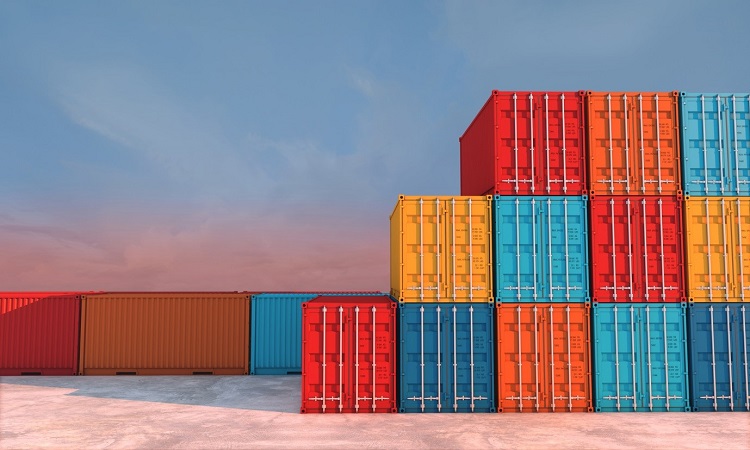Shipping containers account for 80% of all goods transported by sea. It is thought there are over 100 million containers worldwide used in the shipping industry. At any point in time, there are hundreds of thousands of these containers traveling all over the world.
For such a prevalent resource, it is incredible that we barely give them a second thought. In this article, we’re going to share 15 awesome facts about these containers. What may seem to be a boring piece of metal is, in fact, an amazing story.
Remember that shipping containers are the lifeblood of world trade and silently affect a significant part of everyone’s life. The next time you see one of these pass you by on the highway, you’ll remember these shipping facts and feel compelled to share them with others.
- What Is the Most Exported Thing in the World?
Trick question this one. You might guess something like rice or fish. Even cars would not be a big surprise. The answer is fresh air.
Millions of containers arrive full of goods and most often return empty. On a more serious note, one of the most exported goods in the world relates to electronic circuits. That testifies to how much society depends on electronic goods in the modern age.
- Born in the Fifties
Shipping containers were born in the 1950s. They were the brainchild of Malcolm Maclean.
He made Forbes rich list in 1982 with hundreds of millions of dollars in the bank. Yet, a few years later, he had to file for bankruptcy with over a billion dollars of debt.
Despite his financial ups and downs, he won many awards and tributes during his lifetime for coming up with the brilliant idea of intermodal containers.
- China Rules
Shipping containers may have started in the U.S, but the Chinese dominate the production market. Over 95 percent of containers are made in China and sent all over the world.
Depending on the container you buy, and where you buy it from, you’ll find that the cost of shipping can be ten times more expensive than the cost of the container itself.
- Containers Float
For a heavy piece of metal shaped like a long box, it is impressive that it can float. Yes, it seems they float just below the water line and stay afloat for up to 2 months. Even stranger is that the bigger the container, the longer they stay afloat, sometimes up to 6 months.
This all starts to make more sense when you realize how well-sealed these containers are. Once the container is closed, there will be a volume of air inside the container and the products being shipped.
Not only that but the dimensions of the container displaces a volume of water equal to its mass which helps it to float for a period of time.
Some estimate as many as 12,000 containers are floating on the high seas right now.
- Live Long and Prosper
Shipping containers are used for about 20 years as functional containers. This is remarkable given that they do not need much maintenance. Some companies choose to depreciate their containers over ten years and then sell them for other purposes.
Shipping containers are very popular as static storage containers. They are often adapted to serve as homes, offices, shops, and numerous other creative applications.
- Lost At Sea
When shipping containers set out for sea, it seems not all of them make it home. About 600 are lost at sea every year. That said, there are some great stories about how some have been lost at sea but still make it home by floating to shore.
There is one particular story that is world-famous. In the early 1990s, a consignment of plastic toys comprising rubber ducks and similar items was lost at sea. Still, they continued to float around the world, traveling thousands of kilometers and turning up in remote places like Hawaii and Alaska. In fact, some oceanographers have used these items to study ocean currents.
- Important Banana Calculations
Everyone wants to know how many bananas can be loaded onto a container ship, right? A large ship can carry 15,000 containers. That’s one of the must-know facts about shipping.
However, that combined with container volume means that almost 750 million bananas can be transported. That is assuming there are no monkey stowaways.
- Frozen Foods
Millions of tonnes of frozen food are shipped all over the world. These frozen food containers are not refrigerated. Instead, the containers are designed to be very efficient at insulating the frozen products within the container.
These special containers are also fitted with fans that move the cool air around the container to help maintain low temperatures. This makes shipping containers the most cost-effective option for transporting frozen goods worldwide.
- Happy Tracking
Every container in the world can be tracked by using its unique identification number. This is important for businesses that import or export goods around the world. Some containers are fitted with their own GPS, but that is expensive and relatively few compared to the majority in the shipping container industry.
- Few Checks
You’re probably not surprised to know that the import and export industry is highly regulated. However, you will be surprised to learn that very few containers are opened and checked.
Some estimate that as few as 2 to 10 percent of containers are checked for their contents. There is a lot of administration involved with shipping containers, but the sheer volume of numbers coming in and going out of the country means that it is impractical to check the majority of them.
- Transporting Liquids
Containers are not big boxes that you can throw anything in. If you want to transport liquids or gases, you need a special ISO container. These types of shipping containers are built to meet a well-defined international standard so that the containers are safe.
Hazardous and non-hazardous chemicals are transported in ISO containers. Once a container has been designated for holding a particular type of shipment, it cannot be changed.
- Container City
Did you know there is a city made out of using shipping containers? This amazing city is in Mexico and goes by the creative name ‘Container City.’ It is a popular tourist attraction open throughout the week.
There are about 50 large containers, all of them with cool designs and a trendy feel.
You will find cafes, book shops, restaurants, and juice bars!
Mexico is not the only place to have a city like this. London also has its own container city. Recycling containers and using them like this is one way of creating green cities.
- To the Moon and Back
In just over one year, the distance traveled by a container is equal to the distance of traveling to the moon and back.
Over a lifetime, containers will travel millions of kilometers all over the world. Who knows, in the future, shipping containers may actually export to the moon.
- Shoe Paradise
Does your show wardrobe need a boost? If you ordered a large container of shoes and wore a pair every day, how long would it take you to wear them all?
One large container can hold about 8000 shoe boxes. That means it would take nearly 22 years for your to wear all of them once. For some people, that’s paradise.
- Nightmare Story
It is possible to get trapped inside a shipping container and survive after many days. In 2011, a man from Bangladesh was working on the containers when he took a rest inside one. Unknown to him and others, he was locked inside while sleeping.
The poor man woke up to find that he was already out at sea. Once you’re inside one of these containers among thousands of others, it is almost impossible for anyone to hear your cries for help.
This man managed to survive 9 days inside the container. He wasn’t lucky enough to be trapped in a container with luxury food goods. Instead, he had to make do with no food or drink.
Shipping Containers Near You
In this article, you’ve read 15 awesome facts about shipping containers. We might have considered them a boring piece of metal, but instead, they have a rich history and have played a world-changing role in commerce and trade. If shipping containers could speak, they would tell amazing sea-faring stories.
Used containers still have lots of life and usage in them. If you’re thinking of buying one to convert, then see if you can learn something about the container’s history, this will be a great story to share with others.
Check out the latest articles on our site that match your lifestyle and interests.







